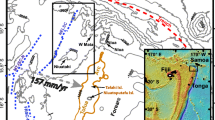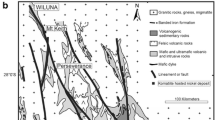Abstract
The tube-fed pāhoehoe lava flows covering much of the northeast flank of Kīlauea Volcano are named the 'Ailā'au flows. Their eruption age, based on published and six new radiocarbon dates, is approximately AD 1445. The flows have distinctive paleomagnetic directions with steep inclinations (40°–50°) and easterly declinations (0°–10°E). The lava was transported ∼40 km from the vent to the coast in long, large-diameter lava tubes; the longest tube (Kazumura Cave) reaches from near the summit to within several kilometers of the coast near Kaloli Point. The estimated volume of the 'Ailā'au flow field is 5.2±0.8 km3, and the eruption that formed it probably lasted for approximately 50 years. Summit overflows from Kīlauea may have been nearly continuous between approximately AD 1290 and 1470, during which time a series of shields formed at and around the summit. The 'Ailā'au shield was either the youngest or the next to youngest in this series of shields. Site-mean paleomagnetic directions for lava flows underlying the 'Ailā'au flows form only six groups. These older pāhoehoe flows range in age from 2750 to <18,000 BP, and the region was inundated by lava flows only three times in the past 5000 years. The known intervals between eruptive events average ∼1600 years and range from ∼1250 years to >2200 years. Lava flows from most of these summit eruptions also reached the coast, but none appears as extensive as the 'Ailā'au flow field. The chemistry of the melts erupted during each of these summit overflow events is remarkably similar, averaging approximately 6.3 wt.% MgO near the coast and 6.8 wt.% MgO near the summit. The present-day caldera probably formed more recently than the eruption that formed the 'Ailā'au flows (estimated termination ca. AD 1470). The earliest explosive eruptions that formed the Keanakāko'i Ash, which is stratigraphically above the 'Ailā'au flows, cannot be older than this age.
Similar content being viewed by others
Author information
Authors and Affiliations
Additional information
Received: 10 October 1998 / Accepted: 12 May 1999
Rights and permissions
About this article
Cite this article
Clague, D., Hagstrum, J., Champion, D. et al. Kīlauea summit overflows: their ages and distribution in the Puna District, Hawai'i. Bull Volcanol 61, 363–381 (1999). https://doi.org/10.1007/s004450050279
Issue Date:
DOI: https://doi.org/10.1007/s004450050279




